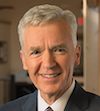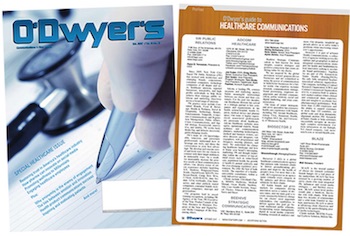|
|
When you work intimately with the professionals who provide care to patients — with physicians, with nurses and leaders of hospitals and health systems — it’s not enough to be good at public relations. Not as PR is traditionally defined. Not today.
It’s not enough to know the tricks of the trade, how to place media, how to build a message platform, how to stage an event, how to execute a digital strategy, how to work that list or move that needle. It’s important, of course, but it’s not enough.
The business of healthcare “delivery” through which care is offered across the country is not merely evolving into a slightly different version of its 100-year-old model. Its challenges stretch beyond the day-to-day of market acquisition, reputation scores and profile management.
|
|
Healthcare — and especially healthcare delivery — is being redefined as an industry. It’s Blockbuster to Netflix. It’s Delta to Southwest. It’s Yellow Cab to Lyft. It’s Tower Records to Spotify. It’s Barnes and Noble to Kindle. Only, no one in the industry knows, for certain, exactly how the healthcare version of Netflix, Southwest or Spotify will manifest.
In this unprecedented moment, the work for senior healthcare communication professionals is to partner with industry’s senior leaders to help them construct, articulate, then traverse a bridge that will lead their organization to the new world. Heady stuff.
The best healthcare public relations work today is change management on steroids where the stakes can be as high as life and death itself.
For the uninitiated or cynical, the last sentence may appear hyperbolic. But for families watching their local hospital close, their healthcare services disappear or move an hour away, for physicians and nurses struggling with exhaustion and shortages, it’s no joke.
People who succeed as healthcare communicators need three key traits. They must be conversant in healthcare. They must bring new ideas to an evolving industry. Finally, they must be flexible and adapt to an industry that’s constantly shifting under their feet.
Know the industry
The most important part of the healthcare industry — what makes it so confusing, but also what makes the work deeply meaningful — is that lives are at stake. Everything starts there. The charge to protect patients lives dictates the dynamic between health systems and the physicians who work there. It explains why it’s difficult to communicate across the system. Front-line nurses, for example, can’t check their email because they on their feet, saving lives.
This life-saving community within a hospital is large and diverse. Its operations require physicians, nurses, administrators, receptionists, janitors, food service employees, technicians and often researchers. For a system to work well, they must all row in the same direction.
Because healthcare is high-stakes and its institutions are big and complex, change happens slowly. Leaders are careful to roll out new, big ideas, given that one unforeseen disruption could jeopardize patient care.
But despite the inertia working against change at a healthcare organization, leaders at hospitals and health systems understand the imperative. The very nature of their business is transforming.
While a health system’s revenue has traditionally depended on the number of patients treated and procedures performed, the industry is moving towards an unknowable future in which healthcare organizations will be compensated for their ability to improve the quality of their patients’ lives.
Contribute fresh ideas
Amid seismic change, healthcare organizations are hungry for smart ideas from other industries. More and more, they are looking to examples outside of healthcare for inspiration. They need people with solid skillsets who can apply innovative ideas to this singular field.
In fact, healthcare consists of so many moving parts that a surprising suite of expertise applies. For example, professionals with manufacturing backgrounds understand complex supply chains. That knowledge is applicable at hospitals, which purchase vast quantities of drugs and devices. People who have worked in retail understand gearing operations towards the consumer. That knowledge is -applicable in healthcare as organizations prepare for a more transparent world and, ultimately, one in which a patient will price shop. Communicators with tech expertise could bring tremendous value to hospitals, which are struggling towards the goal of integrated electronic medical records.
The caveat here is that new ideas must factor in the high stakes and complexity of the industry. To succeed, communicators need to respect the history of healthcare while guiding it towards an uncertain but inevitable new model.
Adapt as you go
The final necessary trait is flexibility. Often, hospitals ask healthcare communicators for solutions to challenges that arise on the spot. There is no blueprint for, say, a new patient experience module because it’s completely novel.
New products and departments and ways of interacting with physicians surface constantly as hospitals transform, merge, partner or sell properties. Communicators often need to build the plane mid-air, so to speak.
Of course, the nature of PR is changing too. The news cycle and the resulting backlash happens faster than ever before. The field is evolving from a playbook of classic, siloed tools such as press releases, websites, print campaigns, etc., towards holistic relationship management.
This means that good healthcare communicators will evolve alongside the shifting industry.
That isn’t easy. And it’s even more difficult to be flexible while contributing fresh ideas and learning the industry’s history.
But the work is necessary. Healthcare needs great communicators to alleviate the pain of massive transitions. As an industry, it needs our help. There is, in fact, no higher calling. Answer it.
***
David Jarrard is President and CEO of Jarrard Phillips Cate & Hancock, Inc.

 David Jarrard
David Jarrard

 Lo Isidro, senior director at Real Chemistry with more than a decade of strategic communications and PA experience, has joined Narrative Strategies.
Lo Isidro, senior director at Real Chemistry with more than a decade of strategic communications and PA experience, has joined Narrative Strategies. Nelson Fernandez, former North American chair of APCO Worldwide and managing director of Burson-Marsteller, has joined Volunteers in Medicine Berkshires as director of communications and PA.
Nelson Fernandez, former North American chair of APCO Worldwide and managing director of Burson-Marsteller, has joined Volunteers in Medicine Berkshires as director of communications and PA. Lilit Bargar, who was most recently an EVP in the healthcare practice at Weber Shandwick, comes on board at GCI Health as EVP, corporate practice lead.
Lilit Bargar, who was most recently an EVP in the healthcare practice at Weber Shandwick, comes on board at GCI Health as EVP, corporate practice lead.
 Five ways that successful thought leaders are made.
Five ways that successful thought leaders are made.


 Have a comment? Send it to
Have a comment? Send it to 
No comments have been submitted for this story yet.